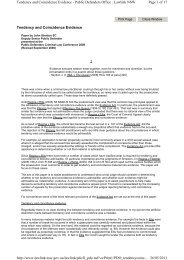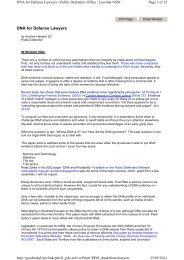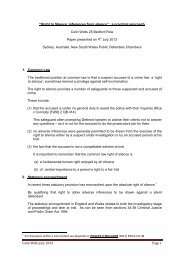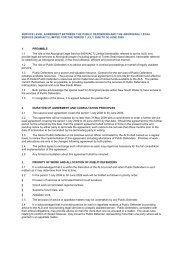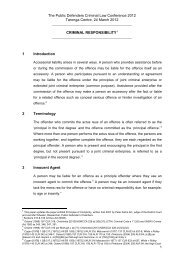Expert Evidence, by Dina Yehia SC - The Public Defenders
Expert Evidence, by Dina Yehia SC - The Public Defenders
Expert Evidence, by Dina Yehia SC - The Public Defenders
You also want an ePaper? Increase the reach of your titles
YUMPU automatically turns print PDFs into web optimized ePapers that Google loves.
All emails and other correspondence in connection to the investigation of the case;<br />
Forensic biology methods manuals on the processing, interpretation and reporting of DNA<br />
evidence;<br />
Gary Edmonds has written extensively on the topic of expert evidence and the importance of assessing<br />
reliability when considering admissibility. He has suggested a number of indicia of reliability that can sharpen<br />
the focus of the cross-examination and may bear upon the judge’s assessment of the admissibility of the<br />
evidence. <strong>The</strong> indicia of reliability are reproduced here: 6<br />
• What is the error rate—for the technique, as well as the equipment and practitioner?<br />
• Has the technique or theory been applied in circumstances that reflect its intended purpose or known<br />
accuracy? Departures from established applications require justification.<br />
• Does the technique or opinion use ideas, theories, and equipment from other fields? Would the<br />
appropriations be acceptable to those in the primary field?<br />
• Has the technique or theory been described and endorsed in the literature? This should include<br />
some consideration of where and <strong>by</strong> whom and with what qualifications.<br />
• Is the reference in the literature substantial or incidental? Is it merely the author’s opinion or<br />
something more?<br />
• Has the publication, technique, or opinion undergone peer review? Logically, peer acceptance of<br />
techniques and theories should take priority over peer review of individual results or applications.<br />
Where the reliability of a technique is unknown, positive peer review may be (epistemologically but<br />
not sociologically) meaningless.<br />
• Is there a substantial body of academic writing approving the technique or approach?<br />
• To what extent is the technique or theory accepted? Is the technique or theory only discussed in<br />
forensic scientific and forensic medical circles? In assessing the extent of acceptance, the judge<br />
should consider what evidence supports acceptance—opinions based on personal impression or<br />
hearsay and incidental references in the relevant literature may not be enough to support claims<br />
about wide acceptance. <strong>The</strong> fact that support comes from earlier judgments rather than scientists or<br />
scientific, technical, and biomedical publications will usually be significant.<br />
• Is the expert merely expressing a personal opinion (ipse dixit)? To what extent is the expert evidence<br />
extrapolation or speculation? Is the expert evidence more than an educated guess? Is this clearly<br />
explained?<br />
• Does the expert evidence actually form part of a field or specialization? Judges should not be too<br />
eager to accept the existence of narrow specializations or new fields based on limited research and<br />
publication.<br />
• Does the evidence go beyond the expert’s recognized area of expertise?<br />
• In determining the existence of a field or specialization, it may be useful to ascertain whether there<br />
are practitioners and experts outside the state’s investigative agencies. If so, what do they think?<br />
• Is the technique or theory novel? Does it rely on established principles? Is it controversial?<br />
• Is the evidence processed or interpreted <strong>by</strong> humans or machines? How often are they tested or<br />
calibrated?<br />
• Does the evidence have a verification process? Was it applied? Were protocols followed?<br />
• Is there a system of quality assurance or formal peer review? Was it followed?<br />
• To what extent is the expert evidence founded on proven facts (and admissible evidence)?<br />
6 Supra n 2 at p 43<br />
21



